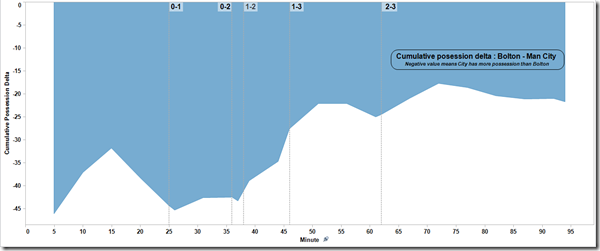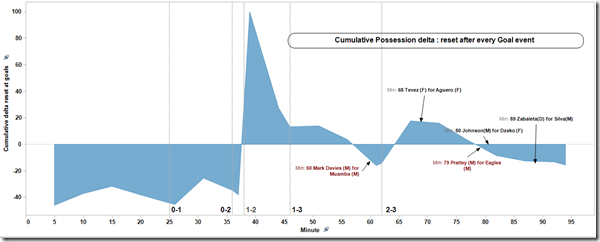This is an “Opposition analysis” of Sunderland, City’s opponent on Saturday 2012/10/6 at the Etihad. I used the #MCFCAnalytics Lite data set to do this analysis.
Disclaimer: The analysis is primarily based on data from 2011-12 season with some data points from the first six games of 2012-13 season.
Sunderland – Offense
| Goals |
1.13 per game – 12th (excluding own goals) |
| Strong on direct free kicks |
5 goals – 1st |
| % of Open play goals |
76% – 4th |
| % of goals from inside the box |
69.7% – 19th |
| % of goals from outside the box |
30% – 2nd |
| Shots on Target |
3.71 per game – 18th |
| Efficiency: Goals/shots On + off Target |
7th |
| Efficiency Inside the box |
16th |
| Efficiency Outside the box |
3rd |
| Assists per Goals scored |
18th |
| Poor from inside the box |
19th in proportion of goals from inside & 16th in efficiency |
| Strong from outside the box |
5th most goals and 3rd most efficient from outside |
| Final 3rd completions / comp % |
16th / 14th |
| Poor in the final third and opposition box |
18th in final 3rd touches & 19th in touches in opp. box |
| Poor in short passingcompletions / comp % |
15th /15th |
| Good in long balls: # of successful / success % |
9th / 8th |
| Good in Open play crosses |
7th in # of crosses & crossing accuracy |
| Very few Through balls |
18th – less than 1 through ball per game |
| Other |
Sunderland just took 6 short corners all season, fewest in the league. |
Sunderland – Key attacking players (2011-12)
| Goals |
Bendtner – 8, Larsson & Sessegnon – 7 each,
McClean – 5 |
| Shots On Target |
Bendtner – 23, Sessegnon – 21, Larsson – 17 |
| Efficiency |
Larsson – 23%, McClean – 17% and Bendtner – 16. % |
| Assists |
Sessegnon – 9, Bendtner – 5 |
| Final 3rd Completions |
Sessegnon – 401, Larsson – 281, Bardsley – 253 |
| Final 3rd Completion% |
Sessegnon – 77.4%, Larsson – 66.27%, Bendtner – 60.6% |
| Touches in opposition box |
Sessegnon – 120, Bendtner – 98 |
Sunderland – Offensive summary
Major personnel changes for 2012-13
IN – Steven Fletcher; OUT – Nicklas Bendtner
Bendtner was highest goal-scorer for Sunderland last season with eight. He also had five assists. Steven Fletcher is doing more than enough to replace him. Fletcher has scored all the five goals of Sunderland so far. There have not been any major changes apart from this.
What the numbers say
A mixture of long balls, great long-range shooting, some great free kicks and accurate crossing were the mainstay of Sunderland’s offense last season. Their attack ran through Stephané Sessegnon, Sebastian Larsson and Nicklas Bendtner.
Sunderland was poor in the final third and even worse from inside the box (19th in touches inside the opposition box). They scored 30% of their goals (13) from outside the box. They do not have a lot of through balls (less than 1 per game, 18th in the EPL) or assists (18th in assists per goal scored). Sunderland was poor in short passing (15th in # of completions and completion %). These stats indicate that Sunderland were very direct in attack. The low # of assists per goal is likely due to Sunderland playing a counterattacking style football. (= a lesser emphasis on interplay between multiple players in the final third to create a chance). They used long balls to good effect to get close to the opponents goal and take shots from outside the box. Their shooting and shooting efficiency from inside the box is poor.
So far this season
Steven Fletcher has accounted for all the five goals Sunderland scored this season. They have a hard time keeping the possession of the ball (like last season). They are unbeaten this season with four draws and a win. Their inability to hold on to leads (or scoring an extra goal) has cost them dearly. They had a lead into the second half in four of the five games but have won only once. Their problems with keeping the ball imply that opponents find it easier to breakthrough, especially in the second half when Sunderland is most likely trying to protect a lead or the point.

Steven Fletcher – One man army, so far. Picture courtesy – dailyrecord.co.uk
Sunderland – Defence
| Goals conceded |
1.21/game – 5th fewest |
| Final 3rd passes completions allowed |
100/game 6th most |
| Short passes allowed |
343/game 2nd most |
| Shots on Target Conceded |
8th fewest |
| Lots of headed clearances |
7th most |
| Fouls conceded |
10.8/game – 8th fewest |
| Tackling machines! |
1stin tackles won76% tackle success rate – 5th highest
5th in last man tackles |
| Weak in aerial duels, strong in ground duels |
19thin % of aerial duels won5th in % of ground duels won |
| Corners |
7th most corners conceded but conceded just 1 goal from corners, fewest in the league |
| Make it easy for opponent GKs |
3rd highest GK distribution success for opponent GKs |
| Opponents get a lot of clean sheets |
3rd highest # of clean sheets for opponents |
Sunderland – Defensive summary
Based on the numbers, Sunderland is a clean tackling defence who do not concede many shots on target. However, they allow opponents a lot of short passes & pass completions in the final third. This indicates that they are likely not pressing and defend deep. Opponent GK’s have great success (over 70%, 3rd in the league) distributing the ball against Sunderland, another indicator that they do not press much and defend off the player. Their relatively low foul count is probably indicative of this. They concede a high number of corners but have just conceded one goal off of corners last season. They are strong in ground duels and are one of the worst teams in aerial duels. They also employ a high number of head clearances.
City had a lot of success against Sunderland in the final third with 181 & 167 completions away and home respectively (average: 135). However, this advantage did not translate into shots on target for City. This could be a side effect of their clean tackling and high # of headed clearances.
Sunderland – Goalkeeping – Simon Mignolet
| Goals conceded overall |
1.13/game – 6th fewest |
| Goals from outside |
0.31/game – 4th most in the league |
| Saves made |
3.2/game – 7th most |
| GK distribution efficiency(Successful GK distribution/Total GK distribution) |
17th of 18 GKs with 29 or more starts |
| Long passes completion |
34% – 16th of 18 |
| Short passes completion rate |
77.4% – 17th of 18(53 attempts 2nd fewest) |
| Ratio of Long to short passes |
90-10 |
Sunderland – Goalkeeping Summary
Mignolet is good with saves and does not allow many goals (which, is probably a reflection of the overall defensive scheme, not just the goalkeeper). However, he seems to have trouble distributing and passing the ball. The proportion of long passes of the total passes is highly skewed in favor of the long passes. These numbers indicate that Mignolet hoofs the ball as far as possible and most of the time his passes end in loss of possession.
The low number of short passes and pass completion rate of short passes could be indicative of an overall scheme and/or that Mignolet & the Sunderland central defenders are not very good at passing short from their goal.
This means pressing the ball high in the defensive third of Sunderland could be a very productive strategy for opponents. City forwards might enjoy a lot of success prolonging their possessions in the final third by keeping the pressure on the Sunderland GK and defence.
City vs. Sunderland Head – to – head 2011-12
- Sunderland had great success against City last season. They took four points from the Champions
- At the Etihad, City needed a big comeback from 1-3 down to salvage a point.
- Sebastian Larsson x 2 and Nicklas Bendtner were the scorers for Sunderland. Mario Balotelli x 2 and Alexsandr Kolarov scored for City
- At the Stadium of light, Sunderland upset City 1-0 with a late goal from Di Jong Won.
- City had 181 (away) and 167 (home) completions in the final third, both higher than their average of 135/game. Shots were close to their game averages.
Final word
City is very likely to have a lot of success pressing Sunderland in their defensive third. They might not find it very difficult to pass short and have lengthy possession spells in the Sunderland final third. However, they need to stay patient as Sunderland defend very well as a team. Sessegnon, Fletcher and Larsson are the three players to watch out for at the other end of the pitch.




